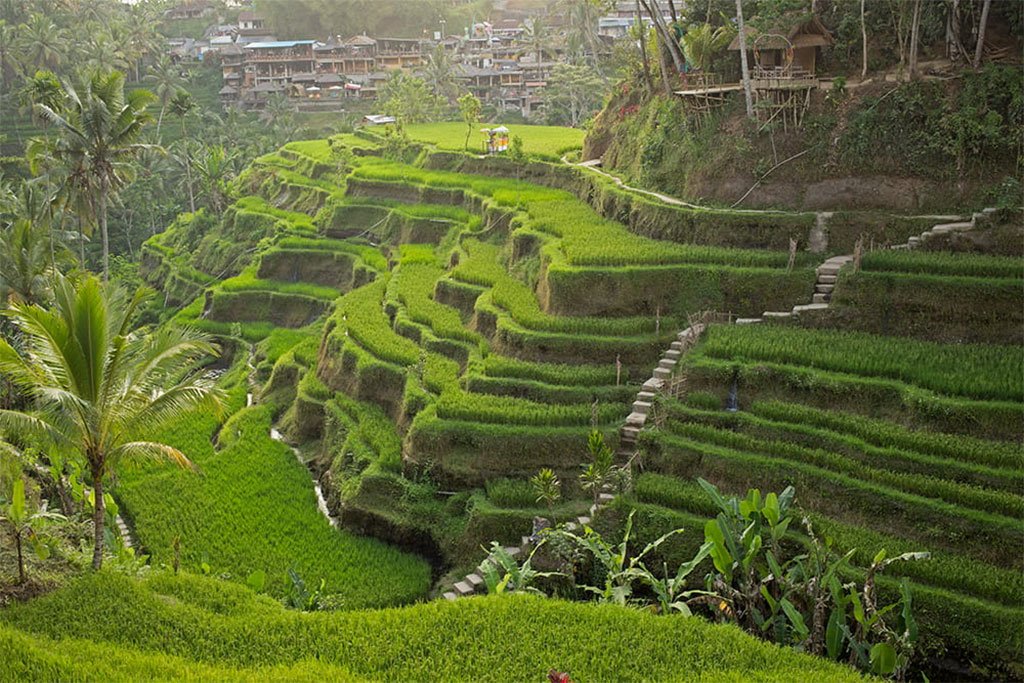How to Photograph Ubud Bali’s Stunning Rice Terraces
Ubud, Bali, is renowned for its lush landscapes, rich culture, and serene atmosphere. Among its most iconic features are the stunning rice... Read More

Ubud, Bali, is renowned for its lush landscapes, rich culture, and vibrant arts scene. While popular spots like the Sacred Monkey Forest and Tegallalang Rice Terraces draw crowds, there are lesser-known treasures waiting to be explored. These hidden gems offer authentic experiences, serene environments, and a deeper connection to Balinese heritage.
Nestled at the confluence of the Campuhan and Sungai Wos rivers, Gunung Lebah Temple is a serene sanctuary away from the bustling streets of Ubud. The temple’s ancient stone carvings and lush surroundings provide a peaceful setting for meditation and reflection. It’s an ideal spot for those seeking spiritual solace in nature’s embrace.
The Kajeng Rice Field Walk offers a picturesque trail through Ubud’s verdant rice paddies. This less-traveled path allows visitors to experience Bali’s rural charm, passing by traditional farming practices and local villages. It’s a perfect route for a peaceful walk, photography, or simply soaking in the natural beauty.
For adventure enthusiasts, Beji Guwang Hidden Canyon presents a thrilling exploration through narrow rock formations and natural pools. This geological wonder, shaped by centuries of water flow, offers a unique experience of wading through waist-deep waters and climbing over smooth rock walls. It’s a must-visit for those seeking an off-the-beaten-path adventure.
Sari Organik is an organic farm and café located amidst Ubud’s rice fields. Visitors can enjoy fresh, locally grown produce while dining in an open-air setting with stunning views. The journey to Sari Organik involves a scenic walk through the paddies, offering a glimpse into traditional farming life.
Adjacent to the Sacred Monkey Forest, Nyuh Kuning Village offers a peaceful retreat into authentic Balinese village life. The village is known for its skilled wood carving traditions and sustainable farming practices. Visitors can explore the village’s charming streets, interact with friendly locals, and experience the simplicity of rural Balinese living.
For those interested in Balinese arts and crafts, Sukawati Art Market provides a less touristy alternative to Ubud’s main market. Here, visitors can find a variety of local handicrafts, textiles, and artworks at more affordable prices. It’s an excellent place to practice bargaining skills and pick up unique souvenirs.
Penglipuran Village is renowned for its well-preserved bamboo forest, offering a peaceful environment for nature walks. The village’s unique layout and traditional Balinese architecture provide a glimpse into the island’s cultural heritage. Visitors can stroll through the bamboo groves, interact with locals, and enjoy the serene atmosphere.
Located at the foot of Mount Agung, Sibetan Village is famous for its Salak (snake fruit) plantations. Visitors can learn about the cultivation process, participate in the harvest, and even try their hand at making Salak wine. This unique experience offers insight into traditional Balinese agriculture and winemaking.
Every evening around dusk, thousands of white herons (kokokan) return to their nests in Desa Petulu, creating a mesmerizing natural spectacle. This phenomenon has been occurring for decades and offers a tranquil setting for birdwatching and reflection. The village’s peaceful ambiance makes it an ideal spot to witness this unique event.
Gunung Kawi Sebatu is an 11th-century water temple dedicated to Vishnu, the Hindu God of Water. Built on a natural spring, the temple has been used for centuries for purification rituals and remains active today. Its tranquil setting and historical significance make it a worthwhile visit for those interested in Balinese spirituality.
Ubud’s hidden gems offer a diverse array of experiences, from tranquil temples and scenic walks to unique cultural encounters. Exploring these lesser-known spots allows visitors to connect more deeply with Bali’s rich heritage and natural beauty. Whether you’re seeking spiritual solace, adventure, or cultural immersion, Ubud’s hidden treasures await your discovery.
Yes, many of the spots like Kajeng Rice Field Walk, Sari Organik, and Nyuh Kuning Village are family-friendly. However, areas like Beji Guwang Hidden Canyon may require adult supervision due to their adventurous nature and physical demands.
The best way is by renting a scooter or hiring a private driver. Many of these locations are tucked away from main roads and may require walking, so wear comfortable shoes and use Google Maps or ask locals for guidance.
Some places are free, such as Kajeng Rice Field Walk and Desa Petulu, while others like Gunung Kawi Sebatu Temple and Beji Guwang Hidden Canyon may charge a small entrance or donation fee (usually under $5 USD).
Yes, especially for locations like Beji Guwang Hidden Canyon or Sibetan Village. Hiring a local guide enhances the experience with cultural stories, safety assistance, and navigation help.
It’s not advisable. To fully enjoy each site, plan to spread your visits over 2–3 days. Each gem offers a different atmosphere and deserves time for exploration and appreciation.
Ubud is generally safe, but when visiting secluded areas like canyons or forests, it’s better to go with a companion or a guide. Always inform someone of your plans and bring a charged phone.
The dry season, from April to October, is ideal for exploration. The paths are less muddy, and visibility is better for both walking and photography.
Wear light, breathable clothing, and sturdy walking shoes. For temples, bring a sarong or wear modest attire. Don’t forget sunscreen, insect repellent, and water.
Unfortunately, most of these places involve uneven paths, stairs, or off-road walks. Only a few (like Sari Organik café) may be partially accessible. Accessibility can be limited.
Absolutely. Small warungs (local eateries) are often nearby, offering authentic Balinese meals like Nasi Campur, Gado-Gado, or fresh coconut water.
Join The Discussion